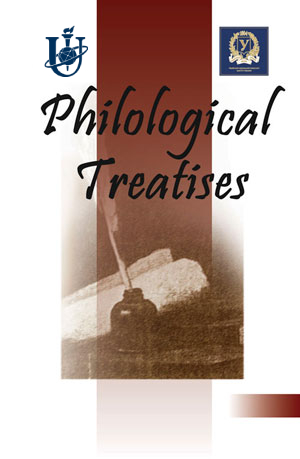LINGUAL MEANS AND TACTICS OF EXPRESSING SENSATIONALISM IN THE HEADLINES OF NEWS ARTICLES ON ECONOMIC SUBJECTS
Keywords:
English neologisms, globalization, sociolinguistic aspect, vocabulary creation, borrowingAbstract
The article investigates lingual means and tactics used in economic news headlines. This research highlights the relevance of studying the role of sensationalism in media discourse, as sensationalism is utilized not only to pique the interest of the media readership but also to manipulate public awareness, promote fake news and spread propaganda. Therefore, examining sensationalism as a pragmalinguistic tool contributes to its implementation and enables media specialists and readers to recognize manipulative techniques used in news articles, as well as to protect themselves from misinformation in the media. The material of the study was news articles on economic topics from Internet publications: City A.M., The Telegraph, and The Guardian. The methodological base of the research includes: methods of analysis and synthesis; method of sampling empirical material; descriptive method; linguistic analysis, in particular discursive, lexical-semantic and functional-stylistic; classification of pragmalingual means; the method of interpretive and textual analysis; as well as the method of generalization aimed at generalizing the obtained results. The following sensationalistic tactics employed in economic news headlines were singled out and analyzed: the tactic of influencing the reader’s emotional state, forward referencing, personalization, the listicle structure, and the “halo of mystery” tactic. The findings of the research demonstrate that lingual means are effective tools for capturing attention and enlarging readership. The research contributes to the fields of pragmatics and media linguistics. The findings enhance our comprehension of how sensationalism shapes the public perception of economic events. Overall, this study contributes to our understanding of headlines as key elements of news articles that influence readers’ interpretation of economic news content and shape their worldview.
References
Видайчук Т. Л., Видайчук К. В. Маніпулятивні тактики в заголовках сучасних українських інтернет-видань. Філологічні студії. 2021. №17. С. 21–29.
Кузьменко О. Ю. Презентація респондента в англійськомовному інтерв’ю масмедійного дискурсу: лінгвокомунікативний і лінгвокогнітивний виміри. : дис... канд. філол. наук: 10.02.04 / Херсонський державний університет. Херсон, 2019. 256 с.
Курченко С. Газетний заголовок як поліфункціональний мовленнєвий акт. Матеріали ІІ студентської науково-практичної конференції, присвяченої Міжнародному дню студента. Харків : ХНПУ, 2019. С. 50–51.
Лакомська І. В. Заголовок мас-медіа у площині лінгвістичного аналізу. Діалог: медіа-студії. 2020. №26. С. 84–95.
Пердейчук Т. І., Садовник-Чучвага Н. В. Семантико-стилістичний аналіз заголовків англомовних статей про Україну. Наукові записки Національного університету Острозька академія. Серія: Філологічна. 2014. №44. С. 226–229.
Савчук Р. І. Стилістичні засоби у заголовках сучасних медіатекстів: психолінгвістичний аспект. Актуальні питання гуманітарних наук. 2020. № 34 (4). С. 161–170.
Сотников А. В. Маніпулятивний вплив у сучасному медіа-дискурсі. Науковий вісник Дрогобицького державного педагогічного університету імені Івана Франка. Сер.: Філологічні науки (мовознавство). 2016. № 5 (2). С. 104–107.
Чумак Л.М. Лексичні інновації в англомовному медійному дискурсі початку ХХІ століття: структурний і лінгвопрагматичний аспекти. : дис... канд. філол. наук : 10.02.04 / Житомирський державний університет імені Івана Франка; Київський університет імені Бориса Грінченка. Київ, 2018. 269 с.
Шепель Ю. Медіа-дискурс як засіб маніпулятивного впливу на читача. Науковий вісник Східноєвропейського національного університету імені Лесі Українки. 2017. №12. С. 302–307.
Ahmadova S. Linguistic Devices Used in Newspaper Headlines. : Master’s Thesis in Linguistics / Khazar University. Baku, 2021. 87 p.
American Press Institute. (2014). How Americans get their news. American Press Institute. URL: https://www.americanpressinstitute.org/publications/reports/survey-research/how-americans-get-news/
Brown D. K., Sinta V. Six Things you Didn’t Know About Headline Writing: Sensationalistic Form in Viral News Content From Traditional and Digitally Native News Organizations. The International Symposium of Online Journalism Research Journal. 2016. № 6. P. 111-130.
Frye W. B. A qualitative analysis of sensationalism in media : Master’s Thesis in Journalism / West Virginia University. 2005. 51 p. URL : https://researchrepository.wvu.edu/etd/3218 (date of access: 24.04.2023)
Iarovici E., Rodica A. The strategy of the headline. Semiotica.1989. № 77 (4). P. 441-460.
Tepavcevic M. Linguistic specificities of media headline discourse – in case of Montenegrin newspapers. Media Dialogues. 2019. № 14(2). P. 75–87.
Xie Q. Analysis of intertextuality in English news headlines. Theory and Practice in Language Studies. 2018. № 8(8). P. 1010-1014.













